day #2: no, i´m not a damned tourist! no, i don´t want to go to antigua!! well, i guess i am a tourist, but i still don´t want to go to antigua...
monday in panajachel was relatively quiet. not that i know what being there during the day on a saturday or sunday is like....but i imagine it is a lot more crowded on the weekends. we ate breakfast (i had pancakes!!!!) next door to the hotel and then went down to the docks where we got our first taste of the whole “you’re a tourist, we think you’re stupid” attitude. we wanted to go to some of the other pueblos on the lake and so this guy acting as a middleman for the lanchas tells us that the public lanchas only go to certain pueblos and that if we wanted we could get a private lancha to go to the pueblos we wanted. we didn’t want to do that, so we said we’d just go to santiago atitlán because we both wanted to go there anyway. then he says – well, there’s these three people that want to go to these other pueblos and that if we want to go with them it’ll be cheaper than a private lancha. so we’re like – ok. so we wait around and finally the guy in charge of the boat says he doesn’t want to go with less than seven people. and one of the three people that were waiting with us was like “well, we need to go because we’ve been waiting here forever” and apparently the other two people – this couple – needed to be back because they were headed to antigua later that day. and the guy was like “well we can’t go because there’s only five people.” and i’m looking around and there’s nobody else coming, no other tourists or anybody that looked like they were gonna add to our five-people party. finally i’m like “look, we’ll just go to santiago on the public lancha” because i wasn’t about to stand around while they screwed us. and i felt bad for the poor girl that was waiting with us because her problem was that she’d bought a ticket from an agency or something to go to these certain pueblos on the lancha and the guy was telling her it wasn’t possible because he wasn’t going to go with only one person, or three people, or five people. she finally just gave in as well as the couple and came with us on the public lancha – which will go no matter how many people are on it. if i were that girl though, i would’ve went back to the agency and complained because that’s bullshit.
anyway, so we take off in this lancha and it’s absolutely beautiful being out on the lake. the water was amazingly blue and clear and the views of the volcanoes san pedro and tolimán were breathtaking. there was some cloud cover over the tops of the volcanoes so you couldn’t get the whole enormity of it all, but just seeing yourself surrounded by the mountains and volcanoes while in the middle of the lake was so incredible.
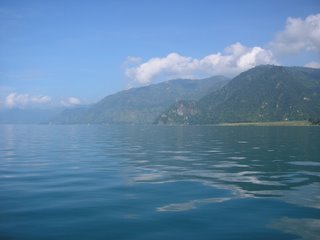 view from the boat
view from the boat
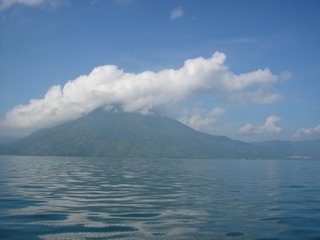 that´s volcán san pedro on the other side of the lake from panajachel
that´s volcán san pedro on the other side of the lake from panajachel
the lancha headed to the eastern side of volcán san pedro, into this bay area and we approached the docks in santiago atitlán. there were lots of men out in small fishing boats, seemingly relaxed while waiting for their catches of the day. they paid no attention to our boat as it roared by and slipped into the dock. we were greeted by children begging for us to “hire” them to take us through santiago. we never asked anybody to take us through santiago, but this 12-year old kid attached himself to us and began walking us through the market on the lakeshore. the market was overwhelming – blankets, bags, bracelets, wall hangings, shirts, bags, purses, pants, everything you could imagine – all in these bright colors and traditional patterns. everyone wanting you to buy from them, wanting you to look at their products “mira – it’s very beautiful.” it was disconcerting hearing them say these short phrases in english, with pretty good pronunciations. “good price, for you,” “what price you want?” “beautiful, look, cotton from atitlán.” i’m sure it’s the same at every other area of the world that caters to tourists or outsiders inundated by the abundance of something that is different from what is normally sold in the tourist’s home-country. there were beautiful hand-made things and a lot of crap too and while i was mesmerized by it all, i was also a little irritated – not with the people selling their wares, but the idea of the whole thing. i’ll talk about that later, though.
we continued through santiago and cut up this side street and stopped in this tienda where i was taken in by this big colorful patchwork blanket i really, really wanted. i bartered for a bit, which i absolutely can’t stand doing. i don’t like bartering, i’m not good at it, and it’s just too tiring. i’m lazy. i want someone to tell me the price and i’ll make a decision whether i want it or not based on that price. and that’s impossible to do. they’d tell me a price, and i’d say i didn’t want it and they’d keep telling me other prices. i think bartering is stressful. anyway, i didn’t bring all my quetzales with me on the trip to santiago so i didn’t have enough even after bartering for a while. i gave up and decided i could do without it or look for something similar in panajachel. courtney, meanwhile, had traded her earrings for a scarf from one of the other women. the whole time, the 12-year old kid that had accompanied us was aiding us in our assessments of which blanket, scarf, etc. was prettier. i told him i wanted to see the church so he led us up around the town square. to my utter amazement the town square was completely filled with avocados. i’m not kidding – i’ve never in my life seen that many vegetables or fruit, let alone avocados, in one place. they were EVERYWHERE. it was like a dream come true. i asked the kid where in the hell these all came from and he said they grow them there. i guess that makes sense. lago atitlán is at a pretty high altitude – about 100 meters higher than apaneca – and avocado trees grow well in higher altitudes.
 tzutuhil woman selling blankets in santiago
tzutuhil woman selling blankets in santiago
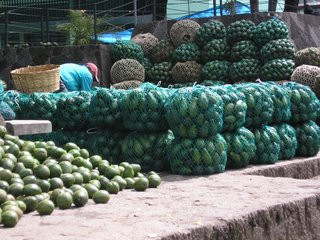 ok, so this was only about 1/16 of the amount of avocados that filled the parque central in santiago
ok, so this was only about 1/16 of the amount of avocados that filled the parque central in santiago
anyway, rigo (our “guide”) led us up to the plaza in front of the catholic church. as we entered the building, we were greeted with a very simple church – rows of pews, no ornate lighting or alter. but on either side of the church were these statues of saints, the virgin mary, etc., all with colorful shawls or clothing wrapped around them. i asked rigo if this was a mixed church – meaning catholic mixed with the traditional religion of the mayans living in the area. he told me that yes it was a mix of the two – then told us about maximón, the other god that the mayans in this area worship. you can find the maximón house somewhere else in santiago and that house changes often. his “shrine” is always in one of the town’s elder’s homes. anyway, people can go there and give offerings. so back to the church, it really was an experience being there. i was amazed. the group of mayans that live in santiago are the tzutuhil and speak that language. nearly every local that tried to sell us something would speak to us in spanish, and use the broken english words as well, but talk to one another in tzutuhil. it was really interesting listening to them talk to one another, using words i’d never heard before. i also began to notice the difference in the traditional clothing worn by the women in santiago as opposed to panajachel and even the bus ride into panajachel. the shirts of the women in santiago all had some kind of stripes in them, whereas coming into the highlands many of the womens’ shirts were designed with bright, big flowers...no stripes. each pattern signifies something different to each group of maya. it’s hard to explain and the only reason i know something about this is because of my anthropology background. guatemala has a mayan culture, but they’re not simply mayans. depending on where you are in guatemala there are groups within that culture that have their own dress, language and living styles that may be totally different from their other mayan neighbors in other towns in guatemala. i read an ethnography back in one of my cultural anthropology classes which compared two lowland mayan groups in southern mexico: the northern and southern lacandon maya. anyway, they have completely different cultural rituals and ways of living, yet they are still both “mayan.” anyway, i’ll leave the anthropology lesson for another day. i just want to point that out that while we were seeing traditional clothing and hearing a mayan language, it wasn’t exactly “mayan clothing” because it was specific to their mayan group, and the people weren’t speaking “mayan.” rather, they were speaking the language of their specific mayan group. know what i mean? in santiago, the women also wear what’s called a “xocop,” which is a 10 meter-long red strap, which is coiled around and worn on their heads. this is something specific to the tzutuhil and you wouldn’t see a woman from another mayan group wearing the same thing. i’m no expert on the mayan culture, though, and if anyone who knows more about it has anything to add, totally let me know! all i know is what i’ve learned from reading ethnographies and taking mucho anthropology classes and from asking questions from the people who live here.
so back to the church – this was definitely one of the most beautiful churches i’ve ever seen – just because it was so different than any church i’d ever seen. there was a side room where women were kneeling and praying outloud, in tzutuhil, and you could really see the mix of catholicism and their indigenous religion. while in the church i read a carved marble plaque in spanish that gave me a little bit of history of the tzutuhil, the area of santiago and the church itself and i’ll relate that story to you now.
the plaque said that the mayan tzutuhiles possibly came to the lago atitlán area from mexico about 900 years before christ. they named it atitlán which means “place of many waters” or “the hill surrounded by water.” the tzutuhiles dominated the area around lago atitlán and the neighboring pueblos of san lucas tolimán and patulul. the tzutuhiles didn’t make any alliances with other mayan pueblos and were defeated in 1524 by a combination of spanish conquistadores, indigenous mexicans and another mayan group – the cakqhicheles. franciscans arrived in 1538 and the first church and monastery was constructed in 1541 at the mouth of the santiago bay (where our boat docked that morning) which was where the tzutuhil ceremonial center (called “chutunamit” – means mouth of the pueblo) was located. they – the franciscans and the tzutuhiles - moved to the area that is now the center of santiago atitlán and probably constructed a church and monastery in this location in 1542. the church and monastery that are now in this place were constructed in 1571 and finished in 1582. the church has suffered damages from earthquakes and has been renovated and rebuilt various times.
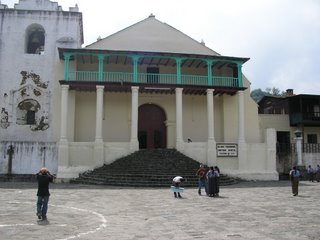 the front of the mixed catholic/tzutuhil church in santiago
the front of the mixed catholic/tzutuhil church in santiago
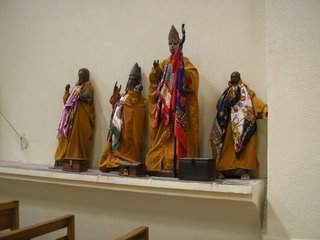 statues inside the church in santiago
statues inside the church in santiago
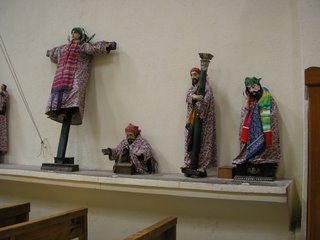
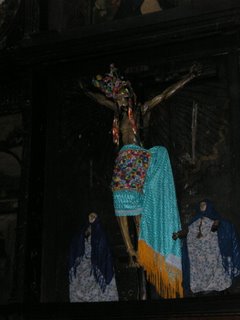

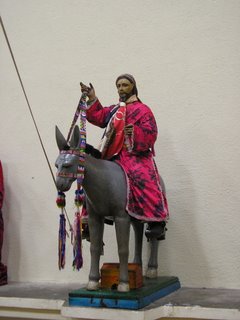
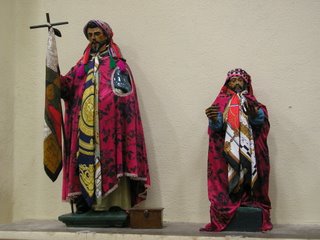

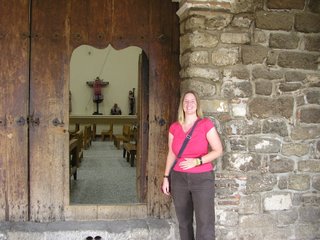 me standing in front of this beautiful wooden door leading to the courtyard of the church
me standing in front of this beautiful wooden door leading to the courtyard of the church
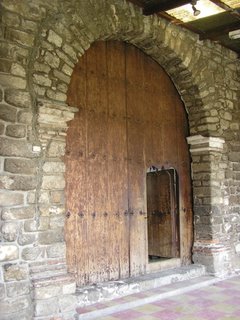
 more cool architecture
more cool architecture
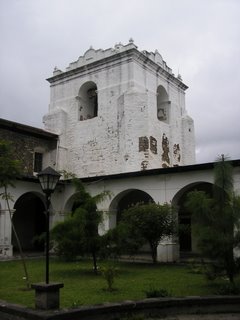 the church belltower
the church belltower
 gate leading to the plaza in front of the church
gate leading to the plaza in front of the church
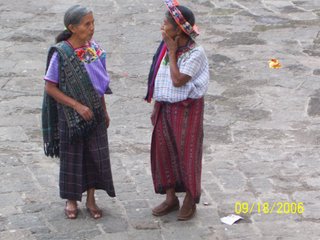 two tzutuhil woman talking in the plaza in front of the church
two tzutuhil woman talking in the plaza in front of the church
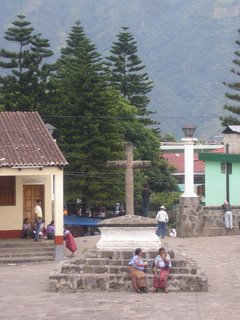
 the street leading from the plaza in front of the church to santiago centro
the street leading from the plaza in front of the church to santiago centro
anyway, not to bore you with historical details – but what do you expect from someone who focused her studies on history and anthropology? seriously? so leaving the church, we went back out onto the plaza and asked rigo if it was ok to go down some side streets. we didn’t want to walk to through the market area anymore because it really was stressful having to say “no gracias” to everyone who wanted you to buy their things. little old women would follow you around with their arms full of scarves and tablecloths and blankets and beg you to buy one of them. one woman followed courtney all the way back down to the docks and courtney ended up buying something just because the woman would not leave her alone no matter how many times courtney said no, or that she didn’t like them. we sat down under this tree and i bought some jocotes from this street vendor and sat there eating them while these women kept coming up with dumb trinkets. it was just sad, really. this one woman came up wearing a xocop and had this basket of these keychains made out of beads in the shape of a quetzal (the bird, not the money). anyway, we asked her her name and it was rosario so we tried talking to her – about her language and culture and she was totally not interested in it. she’d just say “i give you good price.” i told her i wanted to see a real quetzal and she’s like “uh-huh.” i asked her where the real quetzales were and she says, in spanish, “i don’t know. in the mountains.” like she could have cared less, her only mission was selling those dumb keychains. and i know they need the one quetzal or whatever that they sell them for, but it’s just sad that the concept of money and tourists and all that is now a part of their culture too. then, she wanted courtney to take a picture of her. “un photo por un recuerdo de mi.” she wanted courtney to take a picture of her so that courtney could remember her. but she also wanted courtney to give her a quetzal when she was done taking the picture. and it was like “ugh!” then some other woman came up and it was the same thing. and i didn’t want to participate in the whole thing, but i ended up doing so because they were begging for us to do so. and it’s like you know, maybe they have a point too. seriously, how many times over the years have people taken photos of these women, or any women, men, kids living here and then taken those photos and published them and received money for their “cultural” photos. do those photographers – professional or not – then come back there and give any profits to the people whose pictures were taken? maybe they should get a quetzal or two or twenty for every photo someone takes of them. thing is, i wasn’t trying to take pictures of them in the first place. i was eating jocotes and waiting for the boat. then rigo came back up to us after disappearing for a while and was like “ok, it’s 20 quetzales” - for his tour. i gave him 5 and he was like “what?” i don’t know how much courtney ended up giving him, but i gave him 5. i just wanted to get on the boat where i was away from people wanting me to give them quetzales and buy their things. which didn’t happen because when we got on the boat, these kids came up and were like “give me a quetzal!” and reaching their hands over the side of the boat, literally until the boat left the dock.
the most irritating part about this whole trip – starting with that day – were the tourists that were totally obnoxious. i’m not trying to be a tourist snob, because i was one just like the rest of them, but i do feel a bit different than the “rest” of them. i do speak spanish and i do know what things are supposed to cost here in central america. i speak spanish to the people here, i don’t shout things in english expecting people to understand me. but more than that, i’m interested in the people who live here in el salvador, as well as when i’m on vacation in guatemala. i didn’t go to panajachel because it would be a haven of americans that i could hang out with. i wanted to see the lake and i wanted to learn about the people who live there. i didn’t go there so i could get handmade mayan things in the market at dirt cheap prices. i’m not saying all other tourists are like this, but there seemed to be a lot of people like that. wait ‘til i tell you about the obnoxious woman who got on the boat when we went to san marcos a couple days later. and i guess it left me a little sad that most of what i saw was about money – making money, getting things for as little money as possible, cheating people out of money, etc. and i know it’s just progression and what-not, and it’s possible that tourists getting scammed is payback karma-style for all the shit the u.s. has done in central america countries in the past (i.e. “so we charged an extra 20 quetzales to a couple of dumb americans for a boat ride, at least we didn’t help massacre entire pueblos of indigenous people during the war.” or the whole banana republic thing.) but you know, i wasn’t trying to get deals, really. i told you before, i don’t even like bartering. i just want to pay the same prices as guatemalans or salvadorans or whoever. like that place that served pupusas where we ate that first night....they charged like 75 cents (7-8 quetzales) for a pupusa. that’s crazy, they are between 15-25 cents here in el salvador. the only reason they were 75 cents there was because it was a tourist place and apparently “tourists will pay anything.” i guess it’s the same in the states as well – tourist areas are more pricey – but i think it’s even more disproportionate here. those guys at the docks were charging tourists way more for the boat rides – i just wanted to pay what the guatemalans pay. i didn’t want a deal.
on the other hand, i think it’s sad that some blanket that was handmade by some guatemalan woman is sold for the equivalent of $15-$20 when it’s worth a lot more – at least somebody in the u.s. would sell it for a LOT more. and that’s what some people do....come down here, load up on tons of stuff they bartered for way too low prices, take it all up to the states and put it in pier one imports or wherever and sell it for ten times the price. i know it’s all part of the global economy and market and all that stuff i don’t really understand, but from a cultural perspective, in my opinion, it’s sad. it’s sad that it dominates their lives here when in the past, money had nothing to do with it.
well, whatever. by the time our boat came, it started raining which made for a chilly and wet ride back across the lake. it was actually quite funny – all the choppiness of the lake made the boat jump a lot and we all had sore butts when we finally made it back to the dock in panajachel. after having spent the day in santiago and then walking around panajachel i was super tired again and we basically crashed una otra vez. and i was thanking god one more time for my wool blanket!
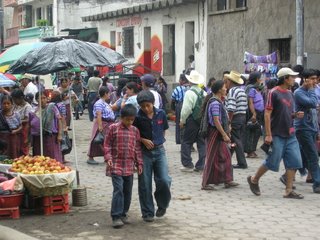 one of the street corners in santiago
one of the street corners in santiago
 one of the girls selling trinkets on the street
one of the girls selling trinkets on the street
 me amongst the wares in the market in panajachel...
me amongst the wares in the market in panajachel...
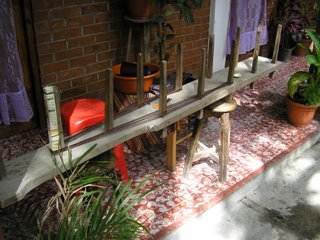 the loom that the woman at the hotel was working on
the loom that the woman at the hotel was working on
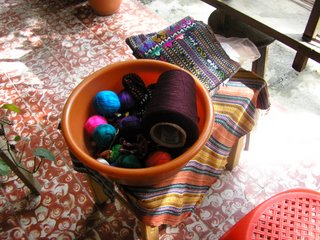 the colorful yarn used in making the different blankets, clothes, purses, etc.
the colorful yarn used in making the different blankets, clothes, purses, etc.
anyway, so we take off in this lancha and it’s absolutely beautiful being out on the lake. the water was amazingly blue and clear and the views of the volcanoes san pedro and tolimán were breathtaking. there was some cloud cover over the tops of the volcanoes so you couldn’t get the whole enormity of it all, but just seeing yourself surrounded by the mountains and volcanoes while in the middle of the lake was so incredible.
 view from the boat
view from the boat that´s volcán san pedro on the other side of the lake from panajachel
that´s volcán san pedro on the other side of the lake from panajachelthe lancha headed to the eastern side of volcán san pedro, into this bay area and we approached the docks in santiago atitlán. there were lots of men out in small fishing boats, seemingly relaxed while waiting for their catches of the day. they paid no attention to our boat as it roared by and slipped into the dock. we were greeted by children begging for us to “hire” them to take us through santiago. we never asked anybody to take us through santiago, but this 12-year old kid attached himself to us and began walking us through the market on the lakeshore. the market was overwhelming – blankets, bags, bracelets, wall hangings, shirts, bags, purses, pants, everything you could imagine – all in these bright colors and traditional patterns. everyone wanting you to buy from them, wanting you to look at their products “mira – it’s very beautiful.” it was disconcerting hearing them say these short phrases in english, with pretty good pronunciations. “good price, for you,” “what price you want?” “beautiful, look, cotton from atitlán.” i’m sure it’s the same at every other area of the world that caters to tourists or outsiders inundated by the abundance of something that is different from what is normally sold in the tourist’s home-country. there were beautiful hand-made things and a lot of crap too and while i was mesmerized by it all, i was also a little irritated – not with the people selling their wares, but the idea of the whole thing. i’ll talk about that later, though.
we continued through santiago and cut up this side street and stopped in this tienda where i was taken in by this big colorful patchwork blanket i really, really wanted. i bartered for a bit, which i absolutely can’t stand doing. i don’t like bartering, i’m not good at it, and it’s just too tiring. i’m lazy. i want someone to tell me the price and i’ll make a decision whether i want it or not based on that price. and that’s impossible to do. they’d tell me a price, and i’d say i didn’t want it and they’d keep telling me other prices. i think bartering is stressful. anyway, i didn’t bring all my quetzales with me on the trip to santiago so i didn’t have enough even after bartering for a while. i gave up and decided i could do without it or look for something similar in panajachel. courtney, meanwhile, had traded her earrings for a scarf from one of the other women. the whole time, the 12-year old kid that had accompanied us was aiding us in our assessments of which blanket, scarf, etc. was prettier. i told him i wanted to see the church so he led us up around the town square. to my utter amazement the town square was completely filled with avocados. i’m not kidding – i’ve never in my life seen that many vegetables or fruit, let alone avocados, in one place. they were EVERYWHERE. it was like a dream come true. i asked the kid where in the hell these all came from and he said they grow them there. i guess that makes sense. lago atitlán is at a pretty high altitude – about 100 meters higher than apaneca – and avocado trees grow well in higher altitudes.
 tzutuhil woman selling blankets in santiago
tzutuhil woman selling blankets in santiago ok, so this was only about 1/16 of the amount of avocados that filled the parque central in santiago
ok, so this was only about 1/16 of the amount of avocados that filled the parque central in santiagoanyway, rigo (our “guide”) led us up to the plaza in front of the catholic church. as we entered the building, we were greeted with a very simple church – rows of pews, no ornate lighting or alter. but on either side of the church were these statues of saints, the virgin mary, etc., all with colorful shawls or clothing wrapped around them. i asked rigo if this was a mixed church – meaning catholic mixed with the traditional religion of the mayans living in the area. he told me that yes it was a mix of the two – then told us about maximón, the other god that the mayans in this area worship. you can find the maximón house somewhere else in santiago and that house changes often. his “shrine” is always in one of the town’s elder’s homes. anyway, people can go there and give offerings. so back to the church, it really was an experience being there. i was amazed. the group of mayans that live in santiago are the tzutuhil and speak that language. nearly every local that tried to sell us something would speak to us in spanish, and use the broken english words as well, but talk to one another in tzutuhil. it was really interesting listening to them talk to one another, using words i’d never heard before. i also began to notice the difference in the traditional clothing worn by the women in santiago as opposed to panajachel and even the bus ride into panajachel. the shirts of the women in santiago all had some kind of stripes in them, whereas coming into the highlands many of the womens’ shirts were designed with bright, big flowers...no stripes. each pattern signifies something different to each group of maya. it’s hard to explain and the only reason i know something about this is because of my anthropology background. guatemala has a mayan culture, but they’re not simply mayans. depending on where you are in guatemala there are groups within that culture that have their own dress, language and living styles that may be totally different from their other mayan neighbors in other towns in guatemala. i read an ethnography back in one of my cultural anthropology classes which compared two lowland mayan groups in southern mexico: the northern and southern lacandon maya. anyway, they have completely different cultural rituals and ways of living, yet they are still both “mayan.” anyway, i’ll leave the anthropology lesson for another day. i just want to point that out that while we were seeing traditional clothing and hearing a mayan language, it wasn’t exactly “mayan clothing” because it was specific to their mayan group, and the people weren’t speaking “mayan.” rather, they were speaking the language of their specific mayan group. know what i mean? in santiago, the women also wear what’s called a “xocop,” which is a 10 meter-long red strap, which is coiled around and worn on their heads. this is something specific to the tzutuhil and you wouldn’t see a woman from another mayan group wearing the same thing. i’m no expert on the mayan culture, though, and if anyone who knows more about it has anything to add, totally let me know! all i know is what i’ve learned from reading ethnographies and taking mucho anthropology classes and from asking questions from the people who live here.
so back to the church – this was definitely one of the most beautiful churches i’ve ever seen – just because it was so different than any church i’d ever seen. there was a side room where women were kneeling and praying outloud, in tzutuhil, and you could really see the mix of catholicism and their indigenous religion. while in the church i read a carved marble plaque in spanish that gave me a little bit of history of the tzutuhil, the area of santiago and the church itself and i’ll relate that story to you now.
the plaque said that the mayan tzutuhiles possibly came to the lago atitlán area from mexico about 900 years before christ. they named it atitlán which means “place of many waters” or “the hill surrounded by water.” the tzutuhiles dominated the area around lago atitlán and the neighboring pueblos of san lucas tolimán and patulul. the tzutuhiles didn’t make any alliances with other mayan pueblos and were defeated in 1524 by a combination of spanish conquistadores, indigenous mexicans and another mayan group – the cakqhicheles. franciscans arrived in 1538 and the first church and monastery was constructed in 1541 at the mouth of the santiago bay (where our boat docked that morning) which was where the tzutuhil ceremonial center (called “chutunamit” – means mouth of the pueblo) was located. they – the franciscans and the tzutuhiles - moved to the area that is now the center of santiago atitlán and probably constructed a church and monastery in this location in 1542. the church and monastery that are now in this place were constructed in 1571 and finished in 1582. the church has suffered damages from earthquakes and has been renovated and rebuilt various times.
 the front of the mixed catholic/tzutuhil church in santiago
the front of the mixed catholic/tzutuhil church in santiago statues inside the church in santiago
statues inside the church in santiago





 me standing in front of this beautiful wooden door leading to the courtyard of the church
me standing in front of this beautiful wooden door leading to the courtyard of the church
 more cool architecture
more cool architecture the church belltower
the church belltower gate leading to the plaza in front of the church
gate leading to the plaza in front of the church two tzutuhil woman talking in the plaza in front of the church
two tzutuhil woman talking in the plaza in front of the church
 the street leading from the plaza in front of the church to santiago centro
the street leading from the plaza in front of the church to santiago centroanyway, not to bore you with historical details – but what do you expect from someone who focused her studies on history and anthropology? seriously? so leaving the church, we went back out onto the plaza and asked rigo if it was ok to go down some side streets. we didn’t want to walk to through the market area anymore because it really was stressful having to say “no gracias” to everyone who wanted you to buy their things. little old women would follow you around with their arms full of scarves and tablecloths and blankets and beg you to buy one of them. one woman followed courtney all the way back down to the docks and courtney ended up buying something just because the woman would not leave her alone no matter how many times courtney said no, or that she didn’t like them. we sat down under this tree and i bought some jocotes from this street vendor and sat there eating them while these women kept coming up with dumb trinkets. it was just sad, really. this one woman came up wearing a xocop and had this basket of these keychains made out of beads in the shape of a quetzal (the bird, not the money). anyway, we asked her her name and it was rosario so we tried talking to her – about her language and culture and she was totally not interested in it. she’d just say “i give you good price.” i told her i wanted to see a real quetzal and she’s like “uh-huh.” i asked her where the real quetzales were and she says, in spanish, “i don’t know. in the mountains.” like she could have cared less, her only mission was selling those dumb keychains. and i know they need the one quetzal or whatever that they sell them for, but it’s just sad that the concept of money and tourists and all that is now a part of their culture too. then, she wanted courtney to take a picture of her. “un photo por un recuerdo de mi.” she wanted courtney to take a picture of her so that courtney could remember her. but she also wanted courtney to give her a quetzal when she was done taking the picture. and it was like “ugh!” then some other woman came up and it was the same thing. and i didn’t want to participate in the whole thing, but i ended up doing so because they were begging for us to do so. and it’s like you know, maybe they have a point too. seriously, how many times over the years have people taken photos of these women, or any women, men, kids living here and then taken those photos and published them and received money for their “cultural” photos. do those photographers – professional or not – then come back there and give any profits to the people whose pictures were taken? maybe they should get a quetzal or two or twenty for every photo someone takes of them. thing is, i wasn’t trying to take pictures of them in the first place. i was eating jocotes and waiting for the boat. then rigo came back up to us after disappearing for a while and was like “ok, it’s 20 quetzales” - for his tour. i gave him 5 and he was like “what?” i don’t know how much courtney ended up giving him, but i gave him 5. i just wanted to get on the boat where i was away from people wanting me to give them quetzales and buy their things. which didn’t happen because when we got on the boat, these kids came up and were like “give me a quetzal!” and reaching their hands over the side of the boat, literally until the boat left the dock.
the most irritating part about this whole trip – starting with that day – were the tourists that were totally obnoxious. i’m not trying to be a tourist snob, because i was one just like the rest of them, but i do feel a bit different than the “rest” of them. i do speak spanish and i do know what things are supposed to cost here in central america. i speak spanish to the people here, i don’t shout things in english expecting people to understand me. but more than that, i’m interested in the people who live here in el salvador, as well as when i’m on vacation in guatemala. i didn’t go to panajachel because it would be a haven of americans that i could hang out with. i wanted to see the lake and i wanted to learn about the people who live there. i didn’t go there so i could get handmade mayan things in the market at dirt cheap prices. i’m not saying all other tourists are like this, but there seemed to be a lot of people like that. wait ‘til i tell you about the obnoxious woman who got on the boat when we went to san marcos a couple days later. and i guess it left me a little sad that most of what i saw was about money – making money, getting things for as little money as possible, cheating people out of money, etc. and i know it’s just progression and what-not, and it’s possible that tourists getting scammed is payback karma-style for all the shit the u.s. has done in central america countries in the past (i.e. “so we charged an extra 20 quetzales to a couple of dumb americans for a boat ride, at least we didn’t help massacre entire pueblos of indigenous people during the war.” or the whole banana republic thing.) but you know, i wasn’t trying to get deals, really. i told you before, i don’t even like bartering. i just want to pay the same prices as guatemalans or salvadorans or whoever. like that place that served pupusas where we ate that first night....they charged like 75 cents (7-8 quetzales) for a pupusa. that’s crazy, they are between 15-25 cents here in el salvador. the only reason they were 75 cents there was because it was a tourist place and apparently “tourists will pay anything.” i guess it’s the same in the states as well – tourist areas are more pricey – but i think it’s even more disproportionate here. those guys at the docks were charging tourists way more for the boat rides – i just wanted to pay what the guatemalans pay. i didn’t want a deal.
on the other hand, i think it’s sad that some blanket that was handmade by some guatemalan woman is sold for the equivalent of $15-$20 when it’s worth a lot more – at least somebody in the u.s. would sell it for a LOT more. and that’s what some people do....come down here, load up on tons of stuff they bartered for way too low prices, take it all up to the states and put it in pier one imports or wherever and sell it for ten times the price. i know it’s all part of the global economy and market and all that stuff i don’t really understand, but from a cultural perspective, in my opinion, it’s sad. it’s sad that it dominates their lives here when in the past, money had nothing to do with it.
well, whatever. by the time our boat came, it started raining which made for a chilly and wet ride back across the lake. it was actually quite funny – all the choppiness of the lake made the boat jump a lot and we all had sore butts when we finally made it back to the dock in panajachel. after having spent the day in santiago and then walking around panajachel i was super tired again and we basically crashed una otra vez. and i was thanking god one more time for my wool blanket!
 one of the street corners in santiago
one of the street corners in santiago one of the girls selling trinkets on the street
one of the girls selling trinkets on the street me amongst the wares in the market in panajachel...
me amongst the wares in the market in panajachel... the loom that the woman at the hotel was working on
the loom that the woman at the hotel was working on the colorful yarn used in making the different blankets, clothes, purses, etc.
the colorful yarn used in making the different blankets, clothes, purses, etc.


<< Home